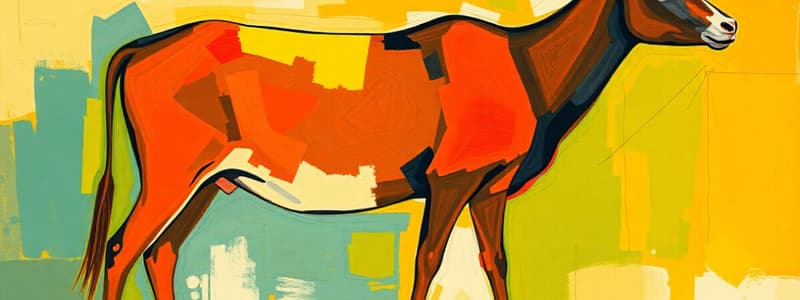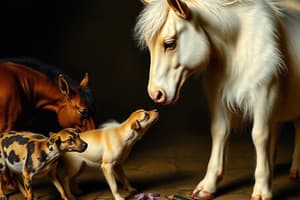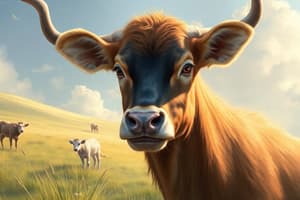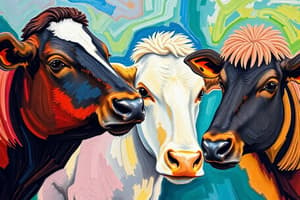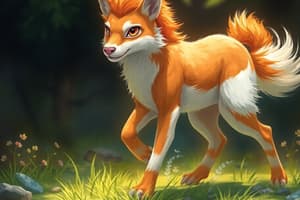Podcast
Questions and Answers
Which of the following best describes domestication?
Which of the following best describes domestication?
- The process of changing a population of living organisms at the genetic level through selective breeding. (correct)
- The process of moving wild animals into a zoo environment.
- The process of an animal learning to perform tricks.
- The process of a plant adapting to a new environment.
According to Belyaev's fox experiment, selecting foxes based on aggression leads to increased tameness and domestication traits.
According to Belyaev's fox experiment, selecting foxes based on aggression leads to increased tameness and domestication traits.
False (B)
What is the primary objective of Belyaev's fox experiment?
What is the primary objective of Belyaev's fox experiment?
Simulate the process that turned wolves into present day dogs.
The neural crest hypothesis suggests that genetic changes to neural crest cells cause domestication traits due to a decrease in the size of the _____.
The neural crest hypothesis suggests that genetic changes to neural crest cells cause domestication traits due to a decrease in the size of the _____.
Match the following terms with their appropriate definitions within the context of animal domestication:
Match the following terms with their appropriate definitions within the context of animal domestication:
Which of the following is associated with tameness in animals?
Which of the following is associated with tameness in animals?
Commensal domestication pathways involve humans actively managing and directing the breeding of animals.
Commensal domestication pathways involve humans actively managing and directing the breeding of animals.
What are two main hormones produced by the adrenal glands that are involved in the stress response and are reduced in domestic animals?
What are two main hormones produced by the adrenal glands that are involved in the stress response and are reduced in domestic animals?
According to the neural crest hypothesis, a smaller number of cells involved in development can lead to a condition known as _____ syndrome.
According to the neural crest hypothesis, a smaller number of cells involved in development can lead to a condition known as _____ syndrome.
Match the pathway to its description:
Match the pathway to its description:
Which of the following is characteristic of extensive animal production systems?
Which of the following is characteristic of extensive animal production systems?
In intensive animal production systems, animals are typically raised in non-confined environments to promote natural behaviors.
In intensive animal production systems, animals are typically raised in non-confined environments to promote natural behaviors.
What are the three main sectors of beef production?
What are the three main sectors of beef production?
A young female bovine is called a _____.
A young female bovine is called a _____.
Match the following terms with their definitions related to swine production:
Match the following terms with their definitions related to swine production:
What is the gestation period for cows?
What is the gestation period for cows?
Modern swine production in Canada emphasizes outdoor, pasture-based systems to improve animal welfare.
Modern swine production in Canada emphasizes outdoor, pasture-based systems to improve animal welfare.
What is the term for giving birth to piglets?
What is the term for giving birth to piglets?
The first milk produced by mammals after giving birth, rich in antibodies, is called _____.
The first milk produced by mammals after giving birth, rich in antibodies, is called _____.
Associate structure with function in dairy cattle
Associate structure with function in dairy cattle
What is the primary purpose of supply management in the Canadian dairy industry?
What is the primary purpose of supply management in the Canadian dairy industry?
Calves are born with fully developed immune systems, making colostrum unnecessary.
Calves are born with fully developed immune systems, making colostrum unnecessary.
What is the role of a national marketing agency in the context of Canadian supply management?
What is the role of a national marketing agency in the context of Canadian supply management?
A license to produce up to a set amount of milk in Canada is called a _____.
A license to produce up to a set amount of milk in Canada is called a _____.
Match the Term with its Definition:
Match the Term with its Definition:
Why are forages important for cow-calf nutrition and management?
Why are forages important for cow-calf nutrition and management?
Canada's Traceability Program for beef cattle is primarily based on consumer preferences and marketing strategies.
Canada's Traceability Program for beef cattle is primarily based on consumer preferences and marketing strategies.
What are the three factors upon which Canada's Traceability Program is based?
What are the three factors upon which Canada's Traceability Program is based?
In Canada's Traceability Program; Cattle must have individual ID and _____ ID, and records must have to leave property.
In Canada's Traceability Program; Cattle must have individual ID and _____ ID, and records must have to leave property.
Associate the Breed with its trait:
Associate the Breed with its trait:
Which of the following best describes how weaned calves are sold?
Which of the following best describes how weaned calves are sold?
The term 'layer' in poultry refers to a meat-producing chicken.
The term 'layer' in poultry refers to a meat-producing chicken.
Why is chicken the most consumed meat in the world?
Why is chicken the most consumed meat in the world?
In poultry terminology, a male chicken is called a _____.
In poultry terminology, a male chicken is called a _____.
Match the poultry term with its accurate description.
Match the poultry term with its accurate description.
What is a primary advantage of supply management in the Canadian poultry industry?
What is a primary advantage of supply management in the Canadian poultry industry?
A key disadvantage of supply management in the poultry industry is that future producers have no purchasing options for quota.
A key disadvantage of supply management in the poultry industry is that future producers have no purchasing options for quota.
What are two detrimental effects that can arise from specialization in horse breeding?
What are two detrimental effects that can arise from specialization in horse breeding?
The first horse was known as _____.
The first horse was known as _____.
Associate the genetic coat colour with its corresponding syndrome.
Associate the genetic coat colour with its corresponding syndrome.
Which of the following represents the correct Latin name for domestic swine?
Which of the following represents the correct Latin name for domestic swine?
Flashcards
What is domestication?
What is domestication?
The process where a living organism's population changes at the genetic level, through selective breeding to accentuate traits that benefit humans.
Examples of domestic animals
Examples of domestic animals
Pets, cats, dogs, horses, cows
Degrees of Domestication
Degrees of Domestication
Wild, tamed, semi-domesticated, and domesticated; Reflecting dependence on humans.
Common traits due to domestication
Common traits due to domestication
Adrenal glands: tameness. Melanocytes: coat color. Chondrocytes: skull. Odontocytes: teeth. Also changes in morphology and floppy ears.
Signup and view all the flashcards
Belyaev's Fox Experiment
Belyaev's Fox Experiment
Selected foxes based on temperament to simulate turning wolves into present-day dogs. Started with 465 foxes.
Signup and view all the flashcards
What is tameness?
What is tameness?
Reduction in stress hormones, reduced fight-or-flight response, decreased reactivity to new situations.
Signup and view all the flashcards
Hormones involved in tameness
Hormones involved in tameness
Produced by adrenal glands; Glucocorticoids (long-term) regulate neonatal development; Catecholamines (short-term) are reduced in domestic animals.
Signup and view all the flashcards
Neural crest hypothesis
Neural crest hypothesis
Genetic changes to neural crest cells which reduce the size of the neural crest, leading to reduced stress and domestication traits.
Signup and view all the flashcards
How was the wolf domesticated?
How was the wolf domesticated?
Wolves with shorter flight distances took advantage of food waste and bred with each other, developing domestication syndrome.
Signup and view all the flashcards
Domestication pathways
Domestication pathways
Commensal pathway: Habituation -> Partnership -> Directed Breeding. Prey pathway: Prey -> Game management -> Herd management -> Directed breeding.
Signup and view all the flashcards
Extensive animal systems
Extensive animal systems
Minimized capital inputs, unprocessed diets, non-confined, minimized handling (Beef cattle, sheep, goat).
Signup and view all the flashcards
Intensive animal systems
Intensive animal systems
Significant capital inputs, processed diets, confinement production (Pork, Dairy, Poultry).
Signup and view all the flashcards
Sector types in Extensive systems
Sector types in Extensive systems
Cow-calf (primary), Pasture and rangeland. Managed with forage/pasture diet and slow growth.
Signup and view all the flashcards
Sector types in Intensive systems
Sector types in Intensive systems
Feedlot/Finishing-Intensive production, Primarily concentrate diets; Packing sector.
Signup and view all the flashcards
Animal lifecycle terms for cattle
Animal lifecycle terms for cattle
Cow: mature female, Heifer: young female, Bull: sexually mature uncastrated male, Steer: castrated male before sexual maturity, Calf: neonatal to 5 months of age
Signup and view all the flashcards
Lifecycle terms - swine
Lifecycle terms - swine
Sow: mature female pig, Gilt: immature female pig, Boar: mature male pig, Barrow: castrated male pig, Piglet: neonatal pig, Farrowing: giving birth.
Signup and view all the flashcards
Modern Swine Production in Canada
Modern Swine Production in Canada
Intensive industry: pigs raised in total confinement with biosecurity. Breeding via artificial insemination.
Signup and view all the flashcards
Farrowing specifics
Farrowing specifics
Sows in crates, 15 piglets average, 1.2 kg birth weight, colostrum intake in 6 hours, 12 teats.
Signup and view all the flashcards
Weaning specifics
Weaning specifics
Transition to solid feed, mixed with other piglets, occurs at 21-28 days.
Signup and view all the flashcards
Grow-Finish specifics
Grow-Finish specifics
After nursery: pigs are housed in large groups and diets change as they mature. Ready for market in 15 weeks with a weight of 125 to 130 kg.
Signup and view all the flashcards
Dairy Production Lifecycle
Dairy Production Lifecycle
Lactation cycle -> lifespan -> calves; Requires lots of calcium; Insufficient calcium causes muscle tremors, staggering, heart failure and death.
Signup and view all the flashcards
Quota system
Quota system
License to produce a set amount of milk set by a national marketing agency, guaranteeing minimum prices with high tariffs on imports.
Signup and view all the flashcards
Why is colostrum important?
Why is colostrum important?
Calves are born with no immunoglobulins; their small intestine absorbs immunoglobulins in first 24 hours (passive immunity).
Signup and view all the flashcards
Forages in beef industry
Forages in beef industry
Forages drive beef industry-pasture, hay, straw, silage; Feed is largest cost, focusing on energy, protein, minerals, vitamins, water.
Signup and view all the flashcards
Three Pillars of Canada's Traceability
Three Pillars of Canada's Traceability
Animal identification (RFID tags), premise identification, and animal movement.
Signup and view all the flashcards
Dominant cattle breeds
Dominant cattle breeds
Angus, Simmental, Hereford, Charolais, and Limousin.
Signup and view all the flashcards
Ways cattle breeds vary
Ways cattle breeds vary
Colour, carcass quality, behaviour, frame size and feed efficiency.
Signup and view all the flashcards
Weaned Calf Sales Methods
Weaned Calf Sales Methods
Sell in groups through auction mart, internet/video, or forward contract: deliver calves for prearranged price.
Signup and view all the flashcards
Poultry terminology
Poultry terminology
Broiler: meat chicken, Layer: table egg production chicken, Rooster: male chicken, Tom: male turkey, Hen: female turkey/chicken.
Signup and view all the flashcards
Why is chicken most consumed meat?
Why is chicken most consumed meat?
Canada's supply management system means we produce as much as we consume.
Signup and view all the flashcards
Advantages of Poultry Supply Management
Advantages of Poultry Supply Management
Producers get steady income and support welfare
Signup and view all the flashcards
Poultry Disadvantage!
Poultry Disadvantage!
Product is pricier and future producers must purchase quota.
Signup and view all the flashcards
Expansion of horse use
Expansion of horse use
First for carrying, then war then riding
Signup and view all the flashcards
Detrimental specialization effects
Detrimental specialization effects
Breeding for small size results in dwarfism. Breeding for heavily muscled quarter horses results in periodic paralysis.
Signup and view all the flashcards
Origin of the domestic pig
Origin of the domestic pig
China (490 BC) and England (800BC); Latin name: Sus scrofa domesticus
Signup and view all the flashcards
Major Canadian swine breeds
Major Canadian swine breeds
Yorkshire (42%), Landrace (32%), Duroc (25%)
Signup and view all the flashcards
Lifecycle Terms - swine
Lifecycle Terms - swine
Swine = pig; Pork = pig meat; Gilt = breeding age, but no piglets; Weaning = separating young.
Signup and view all the flashcards
Cat and dog market trends
Cat and dog market trends
Cat ownership is greater. Cat cost 2,542, dogs cost 3,500
Signup and view all the flashcards
Dogs are different to cats.
Dogs are different to cats.
Dogs changed the way they look and behave and have a better ability to digest carbohydrates, cats have not changed.
Signup and view all the flashcardsStudy Notes
Lecture 1: Domestication and Animal Traits
- Domestication is the genetic modification of a living organism population
- Selective breeding is used to accentuate desirable traits that benefit humans
- Domestic animals include: pets, cats, dogs, horses, and cows
Degrees of Domestication
- Wild animals exibit a "fight or flight" response
- Tamed animals depend on humans to some extent
- Semi-domesticated animals maintain a relationship with humans
- Domesticated animals rely on humans
Common Changes in Traits Due to Domestication
- Adrenal glands are associated with Tameness
- Melanocytes affect coat color
- Chondrocytes relates to reduced skull size
- Odontocytes relate to reduced teeth
- Domestication leads to other morphological changes
- Floppy ears can develop through domestication
Belyaev's Fox Experiment
- Foxes were selected based on temperament
- The experiment began with 465 foxes
- The goal was to simulate the process that turned wolves into modern dogs
- 30% of the foxes were extremely reactive
- 40% were moderately reactive
- 20% were fearful
- 10% were quiet and exploratory
- The foxes that were bred were chosen on how close one could get to them (flight threshold distance)
Tameness and Hormones
- Tameness involves a reduction in the release of stress hormones
- There is a reduced fight-or-flight response in domesticated animals
- Domesticated animals show decreased reactivity to new situations
- The adrenal glands produce hormones
- Glucocorticoids (cortisol) are long-term hormones that regulate neonatal development
- Catecholamines (epinephrine and norepinephrine) are short-term hormones
- Domestic animals have less of short-term stress hormones compared to wild animals
Neural Crest Hypothesis
- Genetic changes to neural crest cells cause domestication traits
- Domestication involves a decrease in the size of the neural crest
- Domestication reduces the number of cells derived from the neural crest
- Tameness occurs due to reduced stress hormone synthesis
- Cells that produce stress hormones come from the neural crest
- Fewer cells being involved leads to domestication syndrome
Wolf Domestication
- Wolves with a short flight distance took advantage of food waste from humans, gaining a competitive advantage
- These wolves would breed together
- These wolves developed domestication syndrome
Domestication Pathways
- Commensal pathway: Habituation -> Partnership -> Directed Breeding
- Prey pathway: Prey -> Game management -> Herd management -> Directed breeding
Lecture 2: Animal Systems, Lifecycle & Production
Extensive vs. Intensive Animal Systems
- Extensive systems involve minimized capital inputs, mainly unprocessed diets that have low nutrients and high fiber density, minimal handling, and animals unconfined
- Examples: Beef cattle, sheep, and goats
- Intensive systems involve significant capital inputs, processed, nutrient-dense diets, confinement production, and economies of scale
- Examples: Pork, dairy, and poultry
Sector Types
- Cow-calf is a primary sector in extensive production, uses pasture and rangeland
- Backgrounding/stocker is managed primarily with a forage/pasture diet, resulting in slow growth
- Feedlot/finishing is an intensive production system
- This uses primarily concentrate diets
- Packing sectors are intensive production
Animal Lifecycle Terms
- Cow: mature female
- Heifer: young female
- Bull: sexually mature uncastrated male
- Steer: castrated male before sexual maturity
- Calf: neonatal to 5 months of age
- Gestation period in cattle is 283 days with 82 days to get pregnant post calving
Pork Terms
- Sow: mature female pig
- Gilt: immature female pig before 2nd pregnancy
- Boar: mature male pig
- Barrow: castrated male pig
- Piglet: neonatal pig before weaning
- Farrowing: giving birth to piglets
Modern Swine Production in Canada
- Pigs are typically in total confinement throughout their lives
- Commercial farms focus on biosecurity
- There are limited visitors
Swine Reproduction
- Breeding is done through artificial insemination
- Gestation lasts 3 months, 3 weeks, 3 days
Farrowing
- Sows are kept in individual crates
- Average litter size is 15 piglets
- Average birth weight is 1.2 kg
- Colostrum intake is important in the first 6 hours
- Most sows have 12 teats
Weaning
- Early weaning is abrupt
- Piglets are moved to a nursery
- Transition from milk to a solid feed
- Piglets are mixed with others
- Age of piglets at weaning is 21-28 days old
Grow-Finish Phase
- Pigs are kept in a nursery for 5 weeks
- Housed in large groups
- Diets are changed as pigs mature
- Ready for market in 15 weeks, 125 to 130 kg
Dairy Production
- The lifecycle is lactation cycle, lifespan, then calves
Parturition and Milk Fever
- Milk fever requires that cows mobilize calcium from the skeleton
- Insufficient calcium can cause muscle tremors, staggering, lying flat on their sides, heart failure, and death
- Treatment is intravenous calcium
Supply Management
- Milk production meets Canadian demand, with limited exports and imports
- A quantity of milk required is established for each province
- A quota is a license to produce up to a set amount of milk
- A national marketing agency determines production amounts and sets quotas for each province
- Producers are guaranteed minimum prices for their products
- High tariffs are implemented to make imported dairy products expensive, favoring consumption of Canadian products
Colostrum
- Calves are born without immunoglobins in their bloodstream
- Passive immunity involves the small intestine absorbing immunoglobins into the blood for the first 24 hours
- Antibodies are Y-shaped proteins that bind to bacteria and viruses
Lecture 3: Beef and Forages
North American Beef Industry
- The beef industry is divided into sectored production systems
- Cow-calf operations are foundational
- Backgrounding involves growing weaned calves on pasture
- Feedlots are for finishing cattle before processing
- Packer facilities handle processing
- There are more than 90,000 producers
Canadian Beef Industry
- The Canadian beef herd consists of 15 million cattle and calves
- Majority of operations are family run
Forages
- Forages are the foundation of the beef industry
- Pasture, hay, straw and silage are forages
- Forage is a major feed component for beef cattle
- Feed is the highest cost in beef production
- Focus is on energy, protein, minerals, vitamins and water
Canada's Traceability Program
- Traceability is based on animal identification, premise identification and animal movement
- Radio frequency identification tags are used for individual animal identification
- Cattle must have individual identification and premise identification to leave the property
Cattle Breeds
- Common breeds include Angus, Simmental, Hereford, Charolais, and Limousin
- They vary in color, carcass quality, behavior, frame size, and feed efficiency
Weaned Calf Sales
- Calves are sold in groups through auction markets
- Internet/video sales are used as sales channels
- Forward contracts with feedlots allow pre-arranged prices
Lecture 4: Poultry Terminology and Supply Management
Poultry Terminology
- Broiler: meat chicken
- Layer: table egg production chicken
- Rooster: male chicken
- Tom: male turkey
- Hen: female turkey or chicken
Chicken Consumption
- In Canada, chicken consumption is supported by supply management
- Canada produces as much chicken as it consumes
Supply Management in Canada
- Predominantly family farms in Canada
- Producers receive steady income
- Many vaccines are available, but some are restricted by politicians
- Operations with over 1000 broilers are considered commercial
Advantages of Supply Management for Poultry
- Steady income for producers
- Steady supply without surplus
- Producers can support animal welfare initiatives
- Boards influence animal welfare practices
Disadvantages of Supply Management for Poultry
- More expensive products for consumers
- Potential producers have to purchase quota
Lecture 5: Horse Domestication and Traits
Evolution Timeline and Domestication
- Equus evolved in North America
- Ancestral migration occurred to Eurasia
- Horses spread across the Eurasian steppes
- Horses were hunted for food initially
- Horses were raised in captivity and domestication was underway
Expansion of Horse Use and Domestication
- Horses were first used for carrying and hauling
- Horses were then used for war tactics
- The usage of horses expanded to riding
Coat Colors and Disadvantages
- Certain coat colors are associated with selective disadvantages
- Melanomas are linked to being grey
- Silver coats have eye disorders (MCOA)
- Leopard Spotting is associated with CSNB
- Overo Pinto is associated with OLWFS
- Splashed white and Overo are related to deafness
- White coats are embryonic lethal
- Roan coats are embryonic lethal
Detrimental Effects of Specialization
- Breeding for small size can cause dwarfism
- Heavily muscled quarter horses can develop periodic paralysis
- Breeding for speed can propagate fragility
- "Popular sire" effect leads to disequilibrium between detrimental genes and performance genes
Lecture 6: Swine Production
Origin and Latin Name
- Pigs that were likely domesticated came from China in 490 B.C. and England in 800 B.C
- The latin name for domestic swine is Sus scrofa domesticus
Canadian Swine Breeds
- Yorkshire (42% of herd)
- Landrace (32%)
- Duroc (25%)
- Other breeds include: Hampshire, Lacombe, Pietrain, Berkshire
Swine Terminology
- Swine refers to pigs
- Pork refers to pig meat
- Sow refers to a mother pig
- Gilt refers to a female of breeding age that hasn't had piglets
- Weaning refers to the removal of young from their mother
- Hog refers to a pig that's nearly ready to be processed
- Process or harvest refers to slaughter
- Boar refers to an adult male pig kept for breeding
- Farrowing refers to parturition
Pork Production in SK
- SK accounts for 8.5% of all pig production
- SK is the 5th largest producer in hogs
Changes in Swine Operations
- Advances in technology and transportation contributed
- Economies of scale contributed
Lecture 7: Dog and Cat Domestication and Pet Ownership
Dog and Cat Ownership
- Cat ownership is greater than dog ownership
- There are 8.5 million cats as pets
- There are 7.9 million dogs as pets
- Pet cat costs average $2,542
- Pet dog costs average $2,500 + $1,000
- There were 770 pet stores in Ontario in 2021
- Brick and mortar stores are declining and online purchases are increasing
Domestication of Dogs and Cats
- Dogs originated in hunter-gatherer societies and descended from an unknown wolf, originally with mutual co-existence and then to companionship
- Domestication changed the way dogs look and behave
- Domestication increased their ability to digest carbohydrate-rich diets
- Cats are more recent, and cats aren't as dependent or responsible to humans as dogs.
- Domestication hasn't changed the way cats look and behave
- Cats easily revert to feral traits
- Diet preference and metabolism remain unchanged from wild cats
Health Benefits and Risks of Pet Ownership
- Benefits include social support, companionship, improves mental health, motivates exercise, provides animal assisted therapy, and helps teach empathy
- Risks include infections, parasites, allergies, bites and injuries, financial burden, psychological burden of pet death or neglect
Animal Assisted Therapy vs. Activities
- Animal assisted therapy is part of treatment for people who are physically, socially, emotionally or cognitively challenged
- There are stated goals and individual treatment
- It is scheduled with detailed notes and is administered by a trained health professional
- Animal assisted activities are casual activities involving pets and people
- There are no specifics
- Typically volunteer run
- Can be as long as necessary
Lecture 8: Dairy Cattle Management and Supply
Supply Management
- Supply management involves milk production that is designed to meet the demand of Canadians
- There are limits to exports and imports of milk and milk products
- A quantity of milk required is established for each province
Dairy Cattle Management
- Dairy cattle are bred through artificial insemination
- Dairy farmers will want to produce a calf every 365 days
- Calves are housed indoors and fed milk or milk replacer
- Typically shifts to a grower phase, promoting rapid lean tissue growth
- Breed at 13-15 months of age to have first calf at 22-24 months of age ensure animals reach weight target rather than age
Key Aspects of Dairy Cattle Management
- Colostrum management and passive transfer
- Changes in milk yield of dairy cattle over time
- Importance of cow-comfort
- Characteristics of the mammary gland
Achieving Genetic Potential
- Cows cannot achieve their full genetic potential without being in a great environment, adequate nutrition, and calm handling
Mammary Gland
- "Take it or lose it" policy applies
- Frequent milking during early lactation stimulates cell development in the mammary gland
- Increased cell development can have carry-over effects
- Nutrient demand increases tremendously in lactation
Lecture 9: Indigenous Principles for Sustainable Aquaculture
Indigenous People
- First Nations, Metis, and Inuit are distinct Indigenous peoples of Canada
- They have their own culture, history, practices and beliefs
Indigenous Principles for Sustainable Aquaculture
- Transparency and First Nations Inclusiveness
- Social responsibility
- Environmental responsibility
- Economic responsibility
Aquaculture Differences
- Aboriginal aquaculture includes cultural and spiritual aspects with unique connections to the land
- Some mistrust of conventional science
- Unique rights and special access to aquatic resources
- Job creation
- High food prices
Studying That Suits You
Use AI to generate personalized quizzes and flashcards to suit your learning preferences.
